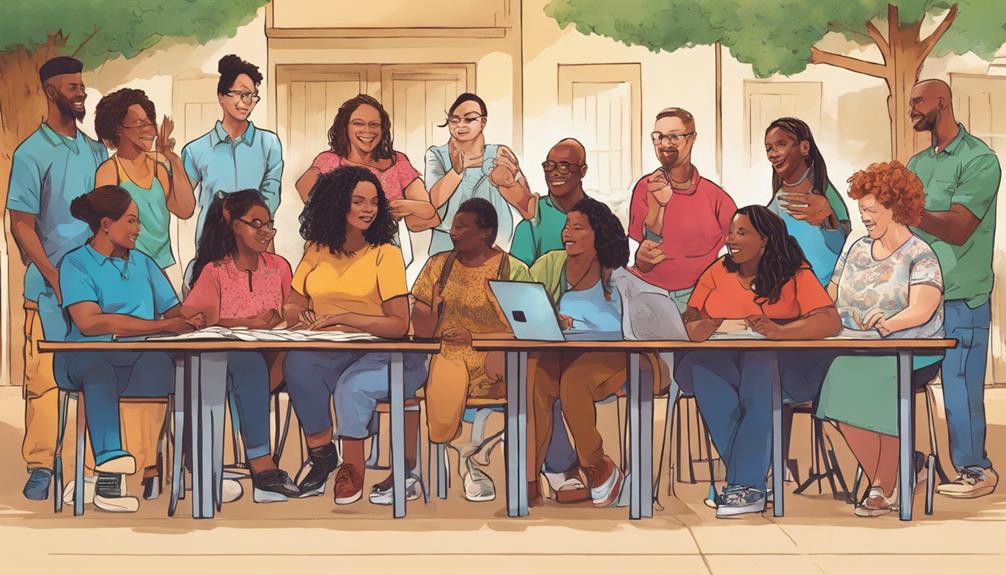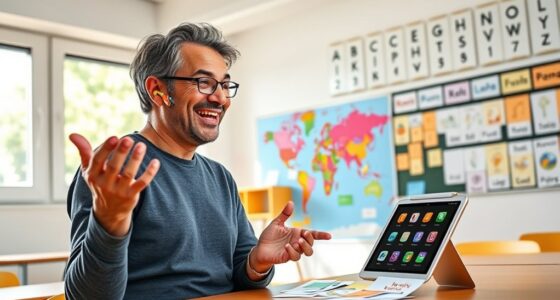Lipreading is a useful skill that helps you understand speech through visual cues like mouth movements, facial expressions, and tongue positions. You don’t need to be naturally talented—practice makes it easier to recognize subtle lip shapes and facial cues during conversations or videos. It’s especially helpful in noisy settings or if you have hearing difficulties. Keep exploring, and you’ll discover simple techniques and tips to improve your daily communication skills.
Key Takeaways
- Focus on observing lip shapes, facial expressions, and contextual cues to improve understanding during conversations.
- Practice lipreading regularly by watching videos or real-life interactions to develop visual perception skills.
- Use mirrors or recording devices to analyze and enhance your ability to interpret subtle mouth movements.
- Incorporate technology like video analysis and machine learning tools to supplement and improve lipreading accuracy.
- Remember that lipreading is a learned skill, and consistent practice boosts confidence and comprehension in everyday situations.

Have you ever wondered how people understand speech without hearing it? It’s a fascinating skill that relies on more than just seeing someone’s lips move. Some individuals, known as famous lipreaders, have mastered this ability to such a degree that they can understand conversations with remarkable accuracy, even in noisy environments or when sound isn’t available. Their talent highlights the incredible potential of visual cues in communication. Today, lipreading isn’t just a skill practiced by a few; it’s also supported by advanced lipreading technology, which enhances understanding for those with hearing impairments or in situations where audio isn’t accessible.
Famous lipreaders like Marlee Matlin and Marlee Martin have showcased how powerful this skill can be, inspiring many to learn and improve their lipreading abilities. They’ve demonstrated that with enough practice, you can interpret speech by focusing on subtle movements of the lips, tongue, and facial expressions. While some might think lipreading is purely instinctive, it’s actually a learned skill that combines visual perception with contextual understanding. Over time, you can pick up on common mouth shapes for different sounds, making it easier to decode conversations even if you miss a word or two.
Famous lipreaders like Marlee Matlin and Marlee Martin demonstrate the power of practice and visual cues in understanding speech.
Lipreading technology has advanced profoundly in recent years, making it more accessible and reliable than ever before. Modern software uses sophisticated algorithms to analyze video footage of speakers and predict what they’re saying. These tools often incorporate machine learning to improve accuracy, especially in challenging conditions like poor lighting or multiple speakers. Some devices even sync with speech recognition software, providing real-time captions that help bridge the gap for those with hearing difficulties. This technology isn’t meant to replace human skills but to complement them, giving you more confidence in understanding speech in everyday life, whether at a busy restaurant or during a video call.
Learning the basics of lipreading can make a big difference in your communication skills. You don’t need to be a famous lipreader to benefit; anyone can start by paying attention to how lips move during conversation. Focus on the shape of the mouth, the position of the tongue, and facial cues that accompany speech. Practice in everyday situations—watching videos, observing people talking, or even practicing with a mirror—can help you become more adept. As you develop your skills, you’ll notice increased confidence in understanding others, especially when sound isn’t an option. Combining traditional lipreading techniques with emerging lipreading technology can open new doors to clearer, more effective communication in your daily life. Additionally, developing these skills can foster active listening and greater empathy in conversations, enriching your interpersonal connections.
Frequently Asked Questions
Can Lipreading Be Effective in Noisy Environments?
Yes, lipreading can be effective in noisy environments. You rely on visual cues like facial expressions and mouth movements to understand speech. Being familiar with the speaker also helps you interpret their words more accurately. By paying close attention to their lip movements and facial cues, you can better fill in missing sounds and improve communication, even when background noise makes auditory cues harder to hear.
How Can I Improve My Lipreading Skills Quickly?
Think of your lipreading skills as a muscle needing quick exercise. To improve fast, focus on observing visual cues and facial expressions, which act like signposts guiding you through conversations. Practice daily by watching people speak, paying close attention to mouth movements and expressions. Use videos or in-person interactions, and gradually challenge yourself with different speakers. Consistent practice sharpens your skills, making you more confident in understanding speech without sound.
Does Age Affect Lipreading Ability Significantly?
Age can impact your lipreading ability, but the effect varies. As you age, age-related decline and cognitive factors may slow down your skills. However, with regular practice, you can still improve. Staying mentally active, engaging in exercises, and using visual cues help counteract some age-related challenges. Remember, your effort and consistency matter more than age itself, so keep practicing and stay motivated to enhance your skills.
Are There Tools or Apps to Assist With Lipreading?
Yes, there are tools and apps that assist with lipreading by leveraging speech recognition and visual cues. These innovative instruments, like video captioning apps, turn silent signals into spoken summaries, making communication clearer. You can use these tools to decode difficult dialogues, improve understanding, and stay socially connected. With the right technology, you’ll find lipreading less limiting and more liberating, enhancing everyday interactions with confidence and clarity.
Can Lipreading Fully Replace Hearing in Communication?
Lipreading alone can’t fully replace hearing in communication. You rely on visual cues like lip movements and facial expressions to understand others, but these aren’t always enough, especially in noisy environments or with complex conversations. Combining lipreading with other strategies, such as hearing aids or sign language, improves understanding. Being aware of context and non-verbal cues helps you communicate more effectively, though complete reliance on lipreading remains limited.
Conclusion
Now that you understand the basics of lipreading, you can confidently navigate conversations like a modern-day Sherlock Holmes solving mysteries at a speakeasy. Remember, it’s about catching those visual clues and piecing them together, even if you feel like you’re trying to read Morse code in a blackout. Keep practicing, stay patient, and soon, you’ll be able to decode speech as effortlessly as a robot in a sci-fi flick. The world opens up when you master this skill.










